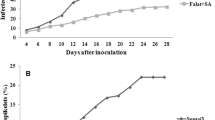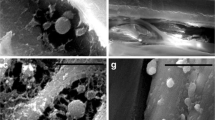Abstract
Annual loss of productivity of the important crop legume chickpea has received prime scientific concern at recent times. Vascular wilt caused by fungal pathogen Fusarium oxysporum f. sp. ciceris race 1 (Foc1) accounts for major share of yield loss of chickpea. Control of this disease remains a challenge due to the lack of appropriate breeding programs to manage fast pathogen mutability. Previous studies with this pathogen have highlighted the role of reactive oxygen species (ROS) as chemical signal in enkindling downstream systemic resistance response instead of activating site specific defense. But the role of salicylic acid in modulating resistance is still unexplored. Present study explains the probable function of salicylic acid (SA) in coordination with ROS. The external SA application reveals the restoration of relative water content of infected susceptible chickpea plants. The qRT-PCR based expression study of key SA biosynthetic genes indicate that the SA biogenesis takes place by the activity of phenylalanine ammonia lyase (PAL) that activates other SA responsive genes and TGA transcription factors to induce an active defense against Foc1. Finally, detection of SA by LC MS/MS along with the accumulation of transcripts of SA marker genes, PR1 and PR5, strengthens the involvement of SA in translocation of distant systemic signals in chickpea-Foc1 interaction.








Similar content being viewed by others
References
Aranega-Bou P, de la O Leyva M, Finiti I, García-Agustín P et al (2014) Priming of plant resistance by natural compounds. Hexanoic acid as a model. Front Plant Sci 5:488. https://doi.org/10.3389/fpls.2014.00488
Barrs HD, Kozlowski TT (1968) Determination of water deficits in plant tissues. Water Deficits Plant Growth 1:235–368
Berrocal-Lobo M, Molina A (2008) Arabidopsis defense response against Fusarium oxysporum. Trends Plant Sci 13(3):145–150. https://doi.org/10.1016/j.tplants.2007.12.004
Bhar A, Gupta S, Chatterjee M, Sen S, Das S (2017) Differential expressions of photosynthetic genes provide clues to the resistance mechanism during Fusarium oxysporum f. sp. ciceri race 1 (Foc1) infection in chickpea (Cicer arietinum L.). Eur J Plant Pathol 148(3):533–549
Chatterjee M, Gupta S, Bhar A, Chakraborti D, Basu D, Das S (2014) Analysis of root proteome unravels differential molecular responses during compatible and incompatible interaction between chickpea (Cicer arietinum L.) and Fusarium oxysporum f. sp. ciceri Race1 (Foc1). BMC Genomics 15(1):949. https://doi.org/10.1186/1471-2164-15-949
Choi WG, Miller G, Wallace I, Harper J, Mittler R, Gilroy S (2017) Orchestrating rapid long-distance signaling in plants with Ca2+, ROS and electrical signals. Plant J 90(4):698–707. https://doi.org/10.1111/tpj.13492
Dempsey AD, Klessig DF (2012) SOS–too many signals for systemic acquired resistance? Trends Plant Sci 17(9):538–545. https://doi.org/10.1016/j.tplants.2012.05.011
Dempsey DMA, Vlot AC, Wildermuth MC et al (2011) Salicylic acid biosynthesis and metabolism. Arabidopsis Book 9:e0156. https://doi.org/10.1199/tab.0156
Fock-Bastide I, Palama TL, Bory S, Lécolier A, Noirot M, Joët T (2014) Expression profiles of key phenylpropanoid genes during Vanilla planifolia pod development reveal a positive correlation between PAL gene expression and vanillin biosynthesis. Plant Physiol Biochem 74:304–314. https://doi.org/10.1016/j.plaphy.2013.11.026
Gatz C (2013) From pioneers to team players: TGA transcription factors provide a molecular link between different stress pathways. Mol Plant-Microbe Interact 26(2):151–159. https://doi.org/10.1094/MPMI-04-12-0078-IA
Gayatridevi S, Jayalakshmi SK, Mulimani VH, Sreeramulu K (2013) Salicylic acid and salicylic acid sensitive and insensitive catalases in different genotypes of chickpea against Fusarium oxysporum f. sp. ciceri. Physiol Mol Biol Plants 19(4):529–536. https://doi.org/10.1007/s12298-013-0184-4
Gupta S, Chakraborti D, Rangi RK, Basu D, Das S (2009) A molecular insight into the early events of chickpea (Cicer arietinum) and Fusarium oxysporum f. sp. ciceri (race 1) interaction through cDNA-AFLP analysis. Phytopathology 99(11):1245–1257. https://doi.org/10.1094/PHYTO-99-11-1245
Gupta S, Chakraborti D, Sengupta A, Basu D, Das S (2010) Primary metabolism of chickpea is the initial target of wound inducing early sensed Fusarium oxysporum f. sp. ciceri race I. PLoS One 5(2):e9030. https://doi.org/10.1371/journal.pone.0009030
Gupta S, Bhar A, Chatterjee M, Das S (2013) Fusarium oxysporum f. sp. ciceri race 1 induced redox state alterations are coupled to downstream defense signaling in root tissues of chickpea (Cicer arietinum L.) PLoS One 8(9):e73163. https://doi.org/10.1371/journal.pone.0073163
Gupta S, Bhar A, Chatterjee M, Ghosh A, Das S (2017) Transcriptomic dissection reveals wide spread differential expression in chickpea during early time points of Fusarium oxysporum f. sp. ciceri race 1 attack. PLoS One 12(5):e0178164. https://doi.org/10.1371/journal.pone.0178164
Haware MP, Nene YL (1982) Races of Fusarium oxysporum f. sp. ciceri. Plant Dis 6:809–810
Hennig J, Malamy J, Grynkiewicz G, Indulski J, Klessig DF (1993) Interconversion of the salicylic acid signal and its glucoside in tobacco. Plant J 4(4):593–600. https://doi.org/10.1046/j.1365-313X.1993.04040593.x
Kumar D (2014) Salicylic acid signaling in disease resistance. Plant Sci 228:127–134. https://doi.org/10.1016/j.plantsci.2014.04.014
Kunkel BN, Brooks DM (2002) Cross talk between signaling pathways in pathogen defense. Curr Opin Plant Biol 5(4):325–331. https://doi.org/10.1016/S1369-5266(02)00275-3
Larkin RP, Fravel DR (1998) Efficacy of various fungal and bacterial biocontrol organisms for control of Fusarium wilt of tomato. Plant Dis 82(9):1022–1028. https://doi.org/10.1094/PDIS.1998.82.9.1022
Lemos M, Xiao Y, Bjornson M, Wang JZ, Hicks D, Souza A, Wang CQ, Yang P, Ma S, Dinesh-Kumar S, Dehesh K (2016) The plastidial retrograde signal methyl erythritol cyclopyrophosphate is a regulator of salicylic acid and jasmonic acid crosstalk. J Exp Bot 67(5):1557–1566. https://doi.org/10.1093/jxb/erv550
Li XY, Gao L, Zhang WH, Liu JK, Zhang YJ, Wang HY, Liu DQ (2015) Characteristic expression of wheat PR5 gene in response to infection by the leaf rust pathogen, Puccinia triticina. J Plant Interact 10(1):132–141. https://doi.org/10.1080/17429145.2015.1036140
Livak KJ, Schmittgen TD (2001) Analysis of relative gene expression data using real-time quantitative PCR and the 2− ΔΔCT method. Methods 25(4):402–408. https://doi.org/10.1006/meth.2001.1262
Mandal S, Mallick N, Mitra A (2009) Salicylic acid-induced resistance to Fusarium oxysporum f. sp. lycopersici in tomato. Plant Physiol Biochem 47(7):642–649. https://doi.org/10.1016/j.plaphy.2009.03.001
Manikandan R, Raguchander T (2014) Fusarium oxysporum f. sp. lycopersici retardation through induction of defensive response in tomato plants using a liquid formulation of Pseudomonas fluorescens (Pf1). Eur J Plant Pathol 140(3):469–480. https://doi.org/10.1007/s10658-014-0481-y
Meher HC, Gajbhiye VT, Singh G, Chawla G (2015) Altered metabolomic profile of selected metabolites and improved resistance of Cicer arietinum (L.) against Meloidogyne incognita (Kofoid & White) Chitwood following seed soaking with salicylic acid, benzothiadiazole or nicotinic acid. Acta Physiol Plant 37(7):1–12. https://doi.org/10.1007/s11738-015-1888-6
Meldau S, Kästner J, von Knorre D, Baldwin IT (2014) Salicylic acid-dependent gene expression is activated by locomotion mucus of different molluscan herbivores. Commun Integr Biol 7(3):e28728. https://doi.org/10.4161/cib.28728
Mukhtar MS, Nishimura MT, Dangl J (2009) NPR1 in plant defense: it’s not over’til it’s turned over. Cell 137(5):804–806. https://doi.org/10.1016/j.cell.2009.05.010
Pan X, Welti R, Wang X (2010) Quantitative analysis of major plant hormones in crude plant extracts by high-performance liquid chromatography–mass spectrometry. Nat Protoc 5(6):986–992. https://doi.org/10.1038/nprot.2010.37
Saikia R, Yadav M, Singh BP et al (2006) Induction of resistance in chickpea by cell wall protein of Fusarium oxysporum f. sp. ciceri and Macrophomina phaseolina. Curr Sci 91:1543–1546
Selitrennikoff CP (2001) Antifungal proteins. Appl Environ Microbiol 67(7):2883–2894. https://doi.org/10.1128/AEM.67.7.2883-2894.2001
Shah J (2003) The salicylic acid loop in plant defense. Curr Opin Plant Biol 6(4):365–371. https://doi.org/10.1016/S1369-5266(03)00058-X
Shah J, Chaturvedi R, Chowdhury Z, Venables B, Petros RA (2014) Signaling by small metabolites in systemic acquired resistance. Plant J 79(4):645–658. https://doi.org/10.1111/tpj.12464
Sticher L, Mauch-Mani B, Métraux AJ (1997) Systemic acquired resistance. Annu Rev Phytopathol 35(1):235–270. https://doi.org/10.1146/annurev.phyto.35.1.235
Summerell BA, Salleh B, Leslie JF (2003) A utilitarian approach to Fusarium identification. Plant Dis 87(2):117–128. https://doi.org/10.1094/PDIS.2003.87.2.117
Tieman D, Zeigler M, Schmelz E, Taylor MG, Rushing S, Jones JB, Klee HJ (2010) Functional analysis of a tomato salicylic acid methyl transferase and its role in synthesis of the flavor volatile methyl salicylate. Plant J 62(1):113–123. https://doi.org/10.1111/j.1365-313X.2010.04128.x
Umemura K, Satou J, Iwata M, Uozumi N, Koga J, Kawano T, Koshiba T, Anzai H, Mitomi M (2009) Contribution of salicylic acid glucosyltransferase, OsSGT1, to chemically induced disease resistance in rice plants. Plant J 57(3):463–472. https://doi.org/10.1111/j.1365-313X.2008.03697.x
Acknowledgments
Authors thank Dr. S.C. Pande (ICRISAT, Patancheru) for providing fungal culture and Dr. S.K. Chaturvedi (IIPR, Kanpur) for providing chickpea seeds. Authors are also thankful to Dr. Kaushik Bannerjee, National Research Centre for Grapes, Solapur, Pune, India, for performing the LC MS/MS of the sample. Unwearied assistance of Mr. Swarnava Das for physiological experiments is greatly acknowledged. Mr. Sudipta Basu is duly acknowledged for seed multiplication. Finally, authors acknowledge the Director, Bose Institute for infrastructural facilities.
Funding
This work was supported by the grant provided to A.Bhar by Council of Scientific and Industrial Research, India (09/015(0378) /2009-EMR-1) and to M.Chatterjee by Department of Biotechnology, Government of India (BT/01/COE/06/03/2006). The funding organizations had no role in study design, data collection and analysis, decision to publish, or preparation of the manuscript.
Author information
Authors and Affiliations
Corresponding author
Electronic supplementary material
Supplementary Table S1
(DOC 51 kb)
Supplementary Table S2
(XLS 645 kb)
Supplementary Table S3
(DOC 63 kb)
Supplementary Table S4
(DOCX 11 kb)
Rights and permissions
About this article
Cite this article
Bhar, A., Chatterjee, M., Gupta, S. et al. Salicylic Acid Regulates Systemic Defense Signaling in Chickpea During Fusarium oxysporum f. sp. ciceri Race 1 Infection. Plant Mol Biol Rep 36, 162–175 (2018). https://doi.org/10.1007/s11105-018-1067-1
Published:
Issue Date:
DOI: https://doi.org/10.1007/s11105-018-1067-1




